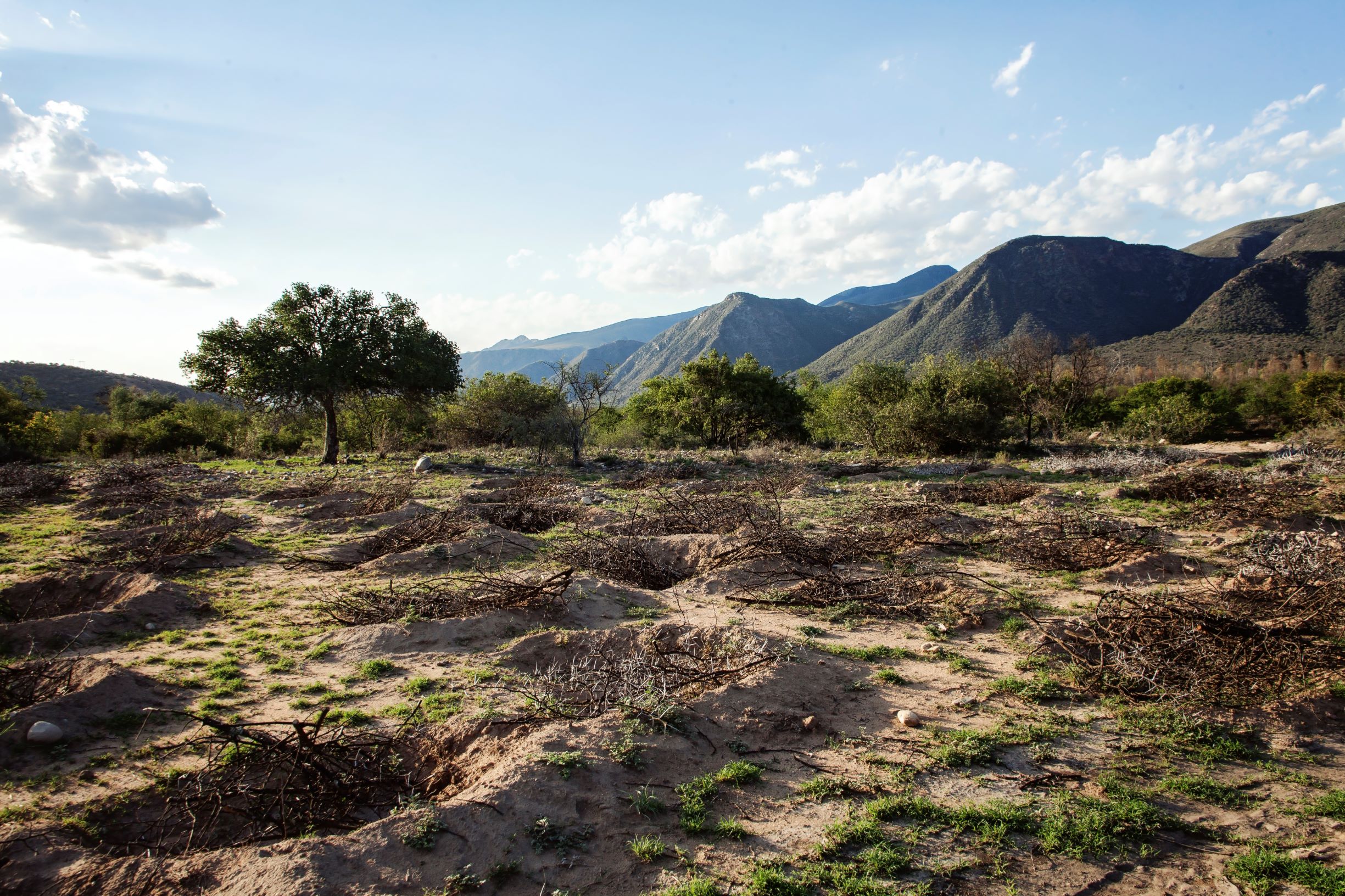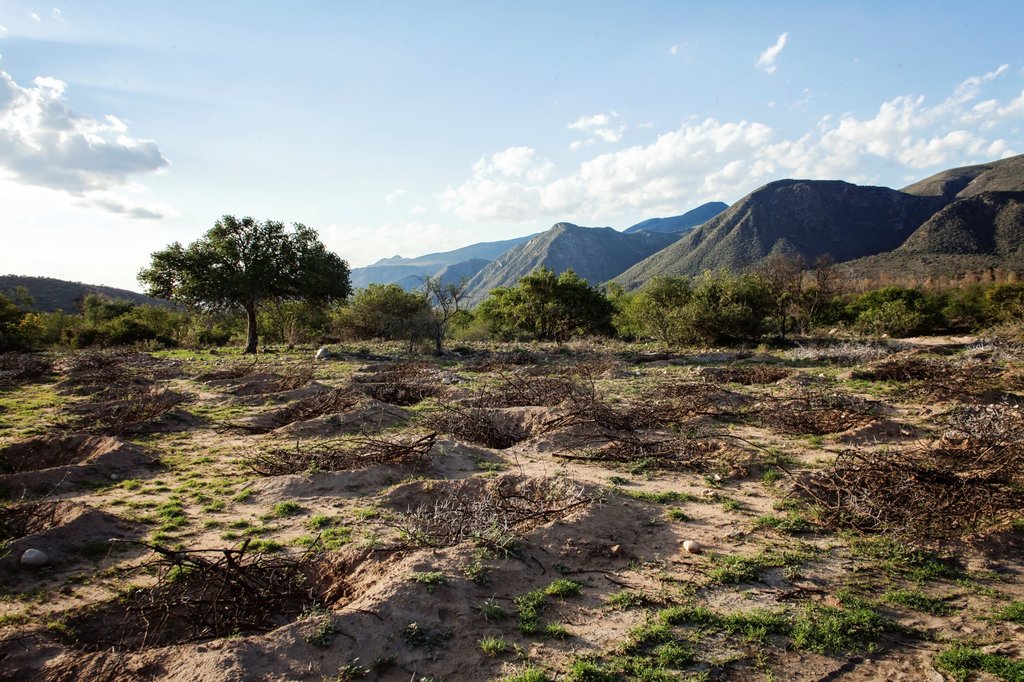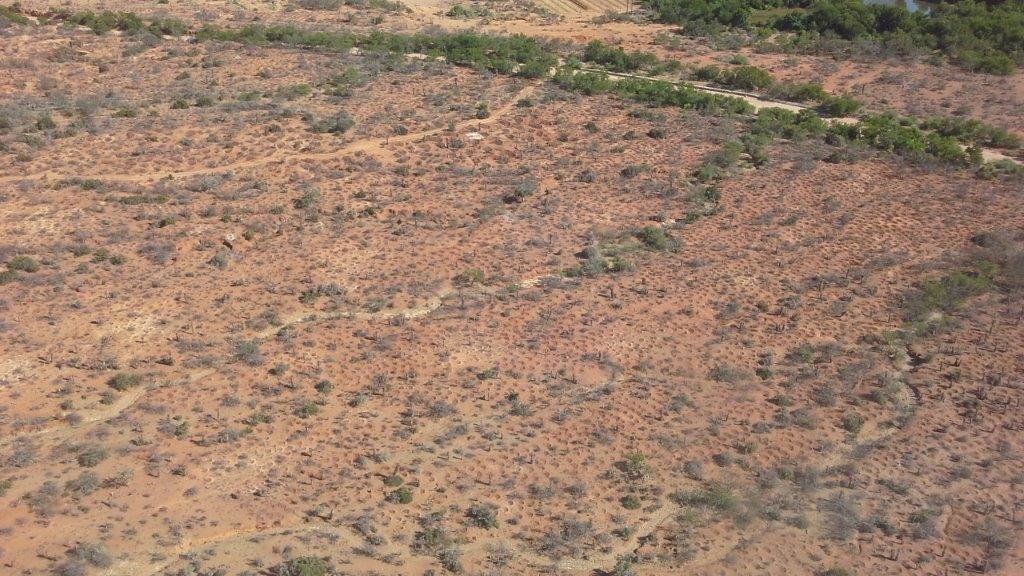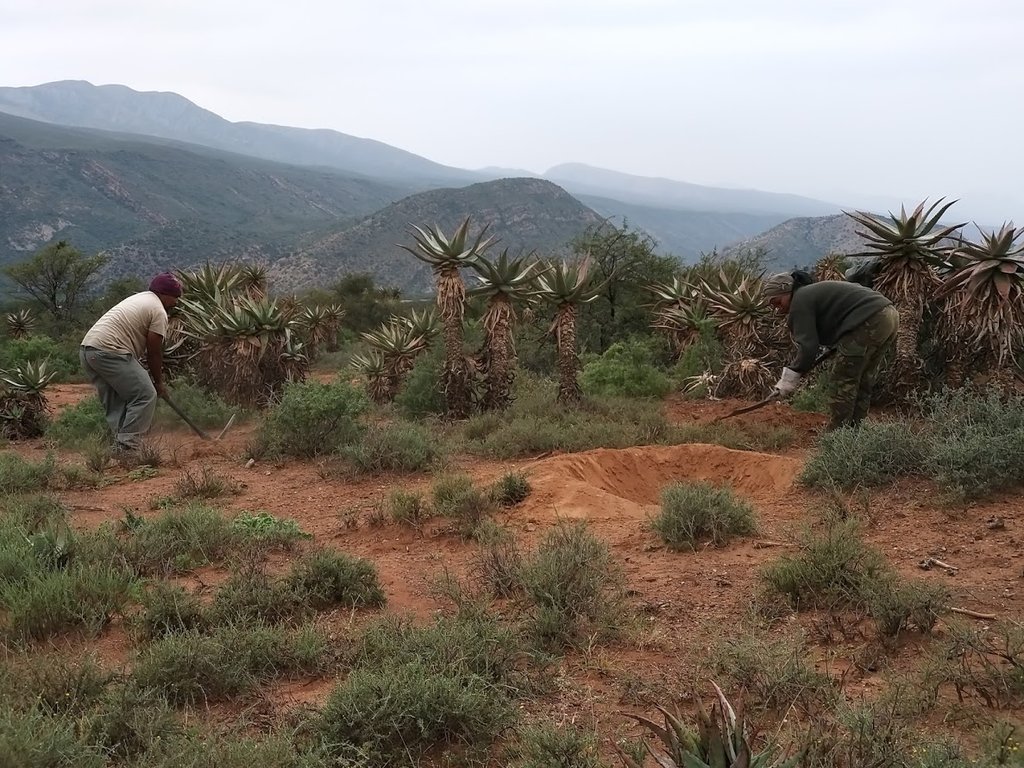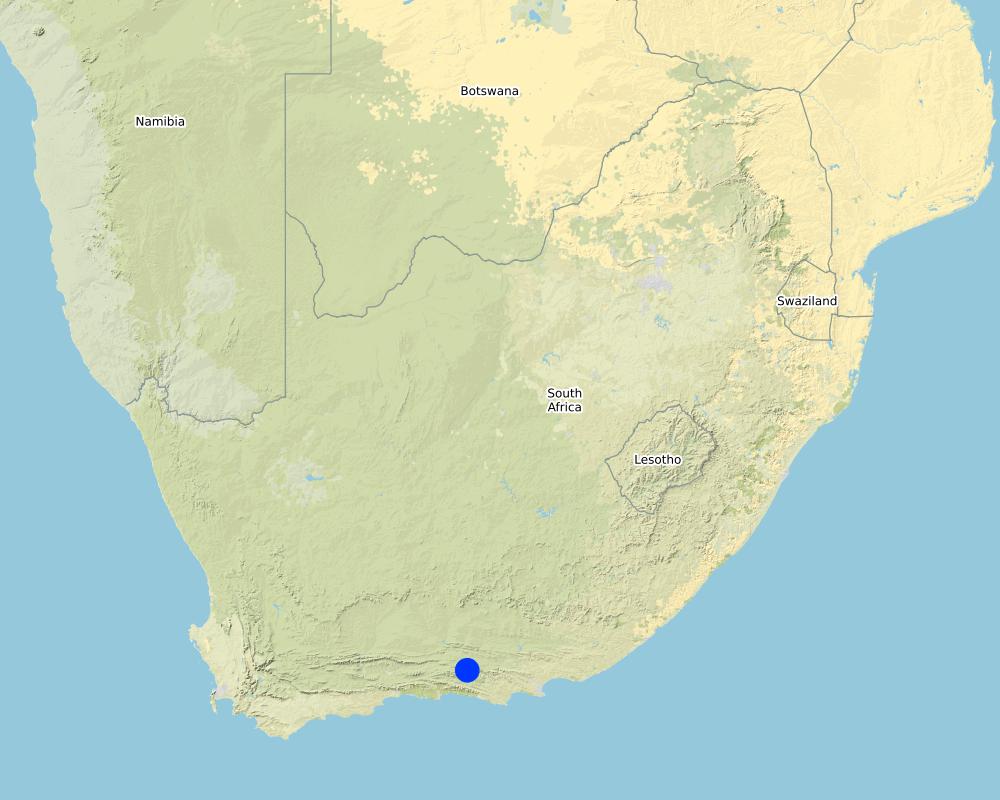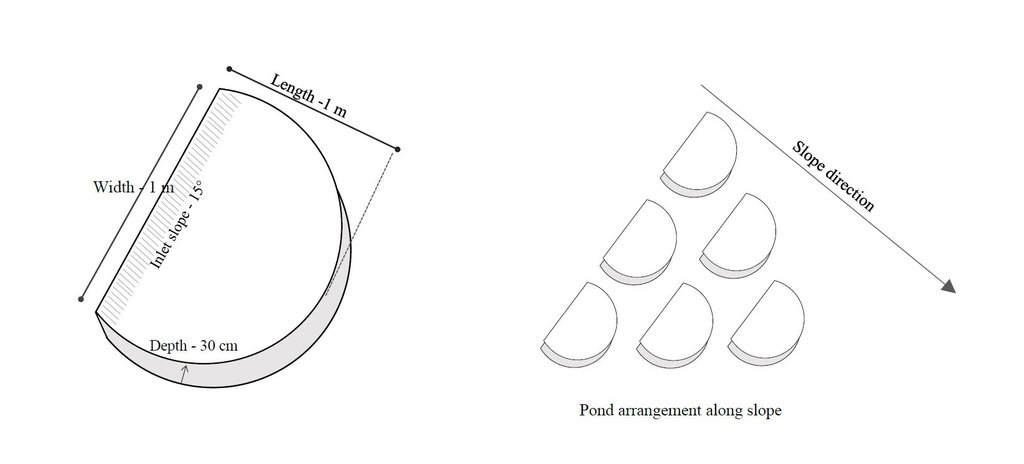Ponds to establish micro catchments, harvest runoff water and reduce soil erosion. [南非]
- 创建:
- 更新:
- 编制者: Lehman Lindeque
- 编辑者: –
- 审查者: Rima Mekdaschi Studer
Ponding
technologies_5801 - 南非
查看章节
全部展开 全部收起1. 一般信息
1.2 参与该技术评估和文件编制的资源人员和机构的联系方式
关键资源人
SLM专业人员:
Beukes Barend Otto
Living Lands
南非
SLM专业人员:
SLM专业人员:
Rudman Justine
Living Lands
南非
SLM专业人员:
Lunderstedt Kyra
United Nations Development Programme
南非
co-compiler:
Gird Justin
Baviaanskloof Hartland Bewaria/Conservancy
南非
有助于对技术进行记录/评估的项目名称(如相关)
Securing multiple ecosystems benefit through SLM in the productive but degraded landscapes of South Africa (SLM)有助于对技术进行记录/评估的机构名称(如相关)
Living Lands (Collaborations working on living landscapes) - 南非有助于对技术进行记录/评估的机构名称(如相关)
Rhodes University (Rhodes University) - 南非1.3 关于使用通过WOCAT记录的数据的条件
编制者和关键资源人员接受有关使用通过WOCAT记录数据的条件。:
是
1.4 所述技术的可持续性声明
这里所描述的技术在土地退化方面是否存在问题,导致无法被认为是一种可持续的土地管理技术?:
否
2. SLM技术的说明
2.1 技术简介
技术定义:
Semi-circular ponds are depressions constructed in the soil to harvest water, reduce runoff, increase infiltration, break soil sealing and crusting, capture organic material and seed where sheet erosion is predominant in degraded, low gradient hillslopes. The opening of the semi-circular pond is up-slope for runoff water to flow into the pond.
2.2 技术的详细说明
说明:
Ponds are applied to disturbed and degraded natural and agricultural areas that have undergone sheet erosion, sealing and crusting on slopes not exceeding 10 degrees. Ponds are constructed of semi-circular hollows dug out of the soil. Ponds are constructed either by hand (micro-ponds) or mechanically using a backhoe-loader or excavator (macro-ponds). Micro ponds are typically 1m wide, 1m long and 30cm deep at its centre, with a water holding capacity of 131 litres. Macro-ponds are typically 3m wide, 3m long and 50cm deep at its centre, with a water holding capacity of approximately 600 litres. The function of ponds is primarily to reduce surface or small rill erosions, reduce water velocity down slope and to harvest water to increase infiltration. Additionally, ponds reduce down-slope siltation of streams, wetlands, dams or reservoirs and even damage to infrastructure like low water bridges, capture seed and organic matter and provide a preferable environment for plant recruitment, particularly in arid areas. Micro-ponds are constructed by pick, to loosen the soil. Loosened soil is then removed by spade and deposited on the downward slope of the pond to form a semi-circular wall similar to that of a dam. The pond wall should be compacted with a spade to reduce breakage during flooding events. Approximately 15% of ponds exhibit broken “dam walls” after two years in extremely arid environments and are greatly dependant on vegetative recruitment. This happened mainly with micro-ponds. Follow-up repairs are advised during the first year, but not thereafter as ponds are also prone to silt up. In arid environments, ponds that do not adequately develop above ground biomass initially are prone to silting closed within three years. Siltation is also dependant on ponding density, spacing and soil type for both micro and macro ponds. The reason for this is they are bigger in size and from our experience, more effective in this arid landscape. Macro-ponds exhibit an increased rate of vegetative recruitment and biomass production, presumably due to less erosion of surface soil and soil nutrients, increased soil moisture content and water retention capacity compared to micro-ponds. Micro-ponds are typically constructed at an average rate of four (4) ponds per hour and 19 ponds per day per person. Production rates are typically 34% lower in hot summer months (2.39 ponds/hour). Macro-ponds are constructed at a rate of approximately 4.43 pond’s per machine hour. Volumetric costs are approximately 31% less expensive when constructed mechanically per litre of water holding capacity. However, large machinery can only be used in severely degraded areas and where access to the project site is available. Ponding density and spacing for micro as well as macro ponds depend on the topography of the landscape to be rehabilitated, the budged and resources available. The more dense, the more effective but also the more expensive the total operation. Some of the threats associated to constructing ponds are soil loss when pond walls break and in the case of steeper slopes may lead to the start of erosion head-cuts if not constructed appropriately. Pond inlets should be constructed at as low gradient decline as possible to reduce the probability of head-cut incision. Ponding at steeper gradients nearing 10-degree slope require particular consideration regarding spacing and density to avoid causing erosion associated to pond breakage. Staggered rows should be considered along the contour. In severely degraded areas, ponds are applied at approximately 400 micro-ponds or 100 mega-ponds per hectare. In severely degraded sites, micro-ponds are applied at approximately 250 ponds per hectare and 160 ponds per hectare in moderately degraded locations. Application rates are greatly determined by soil type and structure, slope, costs and local legislation regarding soil disturbance. Local South African environmental legislation require an Impact Assessment to be done if a certain cubic metres of soil is disturbed, even for rehabilitation purposes. In order to avoid this very costly and tedious approval process, consideration should be given to the amount of soil disturbed or moved. Caution must be taken in severely dispersive soils with regards to soil loss when flooded. Duplex soils are prone to “undercutting” and ponding on these kind of soils should be avoided. Pond depth should be considered with regards to soil water infiltration rates and saturation rate.
The effect of plant growth in and around ponds could also be accelerated or improved by brush packing if material is available in the area. If not, the cost become to high to transport material. Brush packing in the ponds further help to create a micro environment for plant growth by providing a bit of shade, nutrients from the decaying branches and also protection against grazing of newly sprouted plants within the ponds by wildlife occurring naturally in the area. Ponding in semi-arid environments are only used on natural areas, mostly used for grazing of wildlife and livestock. Ponding are usually not used on cultivated fields. Other measures like contours and waterways, vegetative strips are rather used than ponding. There are also very little cultivation happening in semi-arid areas, this project area in Baviaanskloof specifically due to low and unreliable rainfall. Since ponding provide a favourable micro environment for plant growth, grass, shrub and tree species, adaptable and endemic to the area, can be manually planted in the ponds to accelerate vegetative recovery and also to improve the biomass production and species composition in the area. This technology is applied by farmers and land rehabilitation projects. Considering the cost of ponding, it is mainly used in development and restoration projects with donor or government support. In south Africa, this technology is preferred in donor or government funded development project for job creation purposes. Lastly, ponding help reduce soil erosion, increase water infiltration and eventually working towards improve vegetation cover by establishing favourable micro habitats in and around the ponds for vegetation growth. Increased vegetation growth, especially Spekboom, reduced erosion all help to store soil organic carbon and is therefor a carbon mitigation measure as well. Ideally the whole area is withdrawn from grazing for at least 3 years to allow revegation to happen.
2.3 技术照片
2.5 已应用该技术的、本评估所涵盖的国家/地区/地点
国家:
南非
区域/州/省:
Eastern Cape Province
有关地点的进一步说明:
Baviaanskloof
具体说明该技术的分布:
- 均匀地分布在一个区域
如果技术均匀分布在一个区域,则指定覆盖的区域(单位为平方千米):
6.0
技术现场是否位于永久保护区?:
否
Map
×2.6 实施日期
注明实施年份:
2019
如果不知道确切的年份,请说明大概的日期:
- 不到10年前(最近)
2.7 技术介绍
详细说明该技术是如何引入的:
- 通过项目/外部干预
- Existing technology
注释(项目类型等):
GEF 5 Securing multiple ecosystem services through SLM in the degraded but productive landscapes of South Africa. In the described project area, ponding was done mainly through project intervention and also since other projects had great success with the technology in similar landscapes.
3. SLM技术的分类
3.1 该技术的主要目的
- 减少、预防、恢复土地退化
- 保护生态系统
- 结合其他技术保护流域/下游区域
- 保持/提高生物多样性
- 减缓气候变化及其影响
3.2 应用该技术的当前土地利用类型
同一土地单元内混合使用的土地::
否

牧场
粗放式放牧:
- 经营牧场
动物类型:
- 山羊
- 骡子和驴
- 绵羊
- 野生动物 - 大型食草动物
是否实行作物与牲畜的综合管理?:
否

不毛之地
具体说明:
Degraded rangelands
3.3 由于技术的实施,土地使用是否发生了变化?
由于技术的实施,土地使用是否发生了变化?:
- 是(请在技术实施前填写以下有关土地利用的问题)
同一土地单元内混合使用的土地::
否

牧场
粗放式放牧:
- 经营牧场
动物类型:
- 山羊
- 骡子和驴
- 绵羊
- 野生动物 - 大型食草动物
是否实行作物与牲畜的综合管理?:
否
产品和服务:
- 肉类
- 外皮/兽皮
- 毛料

不毛之地
具体说明:
Degraded rangelands
注释:
The change in land use could be potentially from degraded rangeland to more productive rangeland. In this case study, the land is still on its way towards improved productivity, and therefore not utilised at this stage by any livestock.
3.4 供水
该技术所应用土地的供水:
- 雨养
3.5 该技术所属的SLM组
- 改良的地面/植被覆盖
- 集水
- 减少基于生态系统的灾害风险
3.6 包含该技术的可持续土地管理措施

植物措施
- V1:乔木和灌木覆盖层
- V2:草和多年生草本植物
- V5:其它

结构措施
- S4:平沟、坑
- S7:集水/供水/灌溉设备

管理措施
- M1:改变土地使用类型
- M2:改变管理/强度级别
注释:
V5: Packing brush on top of ponds greatly increases vegetative recruitment and survival rates, survival rate of regenerating plants (from seeds or stocks in the soil) and of intentionally newly seeded plants?
3.7 该技术强调的主要土地退化类型

土壤水蚀
- Wt:表土流失/地表侵蚀
- Wg:冲沟侵蚀/沟蚀
- Wo:场外劣化效应

土壤风蚀
- Et:表土流失

化学性土壤退化
- Cn:肥力下降和有机质含量下降(非侵蚀所致)

物理性土壤退化
- Pc:压实
- Pk:熟化和结壳
- Pu:由于其他活动而导致生物生产功能的丧失

生物性退化
- Bc:植被覆盖的减少
- Bh:栖息地丧失
- Bq:数量/生物量减少
- Bs:质量和物种组成/多样性的下降

水质恶化
- Ha:干旱化
- Hs:地表水良变化
- Hg:地下水/含水层水位的变化
- Hp:地表水水质下降
- Hw:湿地缓冲能力下降
3.8 防止、减少或恢复土地退化
具体数量名该技术与土地退化有关的目标:
- 修复/恢复严重退化的土地
- 适应土地退化
4. 技术规范、实施活动、投入和成本
4.1 该技术的技术图纸
技术规范(与技术图纸相关):
The technical drawing on the left shows the measurements of a typical average micro-pond. Its about 1m wide on the upstream (open) end and about 1m to the semi-circular edge wall on the downstream side. The pond should be dug out with a spade at an angle of 15 degrees towards the wall of the pond at the downstream end. Use the removed soil to form the semi-circular edge wall as illustrated on the left hand drawing. Use the spade or your feet to compact the soil of the semi-circular wall.
The drawing on the right illustrates the pond arrangement along a slope. The ponds should be staggered in lines across the contour to make sure the water flowing between ponds in the first line, flows into the ponds in the second line or row. The ponds don't need to be exactly in lines across the contour, but it is very important that the pond openings are perpendicular to the slope direction and form an appearance of fish scales.
作者:
Kyra Lunderstedt
日期:
08/07/2020
4.2 有关投入和成本计算的一般信息
具体说明成本和投入是如何计算的:
- 每个技术区域
注明尺寸和面积单位:
600 ha
其它/国家货币(具体说明):
South African Rand
如相关,注明美元与当地货币的汇率(例如1美元=79.9巴西雷亚尔):1美元=:
15.0
注明雇用劳工的每日平均工资成本:
ZAR 150 - ZAR 262
4.3 技术建立活动
| 活动 | 时间(季度) | |
|---|---|---|
| 1. | Terrain inspection and pecking out pond positions and lines | Any time of the year |
| 2. | Manual digging of micro-ponds | Any time of the year |
| 3. | Seeding of ponds (Optional) | Before or at start of rain season |
| 4. | Brush packing if material is available | Any time of the year |
| 5. | Inspection and maintenance of ponds | During the rainy season, especially after heavy thunderstorms |
注释:
Mainly micro-ponds were used in the area. Macro-ponds where tested for comparison purposes. Equipment needed for macro-ponds Volvo BL61 Backhoe-loader (Vehicle and operator = ZAR 300/hour, Fuel = ZAR 75/hour).
4.4 技术建立所需要的费用和投入
| 对投入进行具体说明 | 单位 | 数量 | 单位成本 | 每项投入的总成本 | 土地使用者承担的成本% | |
|---|---|---|---|---|---|---|
| 劳动力 | Manual digging of micro-ponds | Person-days | 1677.0 | 215.0 | 360555.0 | 0.0 |
| 设备 | Spade | Number | 24.0 | 250.0 | 6000.0 | 0.0 |
| 设备 | Pick | Number | 24.0 | 350.0 | 8400.0 | 0.0 |
| 植物材料 | Grass seeds | 25 kg bags | 10.0 | 250.0 | 2500.0 | |
| 其它 | Transport | km | 15960.0 | 6.2 | 98952.0 | 0.0 |
| 其它 | Staff overheads | Per person day | 1677.0 | 76.0 | 127452.0 | 0.0 |
| 其它 | Management | Per field day | 399.0 | 438.0 | 174762.0 | 0.0 |
| 技术建立所需总成本 | 778621.0 | |||||
| 技术建立总成本,美元 | 51908.07 | |||||
如果土地使用者负担的费用少于100%,请注明由谁负担其余费用:
Living Lands NGO working in the Baviaanskloof. In certain cases, depending on availability of external inputs, farmers could contribute by providing labour for example or use there own tools or transport for workers.
注释:
Donor funding through the United Nations Development Programme, Global Environmental Facility (GEF 5)
4.5 维护/经常性活动
| 活动 | 时间/频率 | |
|---|---|---|
| 1. | Restructuring of broken ponds (S) | After heavy rain event |
| 2. | Densification (S) (More ponds are dug when needed | After rain event and assessment of effective functioning and impact |
| 3. | Supplementary seeding (V) | Dependant on species seasonality |
| 4. | Brush-packing | After ponding to increase plant recruitment & survival |
4.6 维护/经常性活动所需要的费用和投入(每年)
如果您无法分解上表中的成本,请估算维护该技术所需要的总成本。:
25000.0
如果土地使用者负担的费用少于100%,请注明由谁负担其余费用:
Living Lands NGO working in the Baviaanskloof
注释:
Donor funding through the United Nations Development Programme, Global Environmental Facility (GEF 5)
4.7 影响成本的最重要因素
描述影响成本的最决定性因素:
For manually constructed ponds: Climatic conditions, particularly heat. Productivity (labour) is approximately 34% greater in the cooler winter months (April-October) and reduce during summer months with regular temperatures above 30°C. The activity is generally stopped when temperatures exceed 32°C. Soil structure (Clay, Sand and rock proportions particularly) effect production rate and longevity. High rock content and dense silt and clay soils reduce productivity (rate at which ponds are dug manually).
When constructing ponds mechanically, soil structure appears to have the greatest effect on production rates.
5. 自然和人文环境
5.1 气候
年降雨量
- < 250毫米
- 251-500毫米
- 501-750毫米
- 751-1,000毫米
- 1,001-1,500毫米
- 1,501-2,000毫米
- 2,001-3,000毫米
- 3,001-4,000毫米
- > 4,000毫米
指定年平均降雨量(若已知),单位为mm:
280.00
有关降雨的规范/注释:
: 60% summer rainfall, 40% winter rainfall. Thunder storms in summer deposit large quantities at once (>50mm/occasion). 67% standard deviation around mean across 100 years recorded. Peak rainfall September and March, but no predictable long term or annual patterns. Less than half mean annual rainfall per year from 2015-2019 during analysed implementation period. March and April are the only months that have not experienced zero rainfall over a 100-year period. Approximately 30 days per annum are frost prone in the implementation area
农业气候带
- 干旱
PET effects do not exceed 10mm of effective rainfall per month. Approximately 43mm of rainfall per annum is effective
5.2 地形
平均坡度:
- 水平(0-2%)
- 缓降(3-5%)
- 平缓(6-10%)
- 滚坡(11-15%)
- 崎岖(16-30%)
- 陡峭(31-60%)
- 非常陡峭(>60%)
地形:
- 高原/平原
- 山脊
- 山坡
- 山地斜坡
- 麓坡
- 谷底
垂直分布带:
- 0-100 m a.s.l.
- 101-500 m a.s.l.
- 501-1,000 m a.s.l.
- 1,001-1,500 m a.s.l.
- 1,501-2,000 m a.s.l.
- 2,001-2,500 m a.s.l.
- 2,501-3,000 m a.s.l.
- 3,001-4,000 m a.s.l.
- > 4,000 m a.s.l.
说明该技术是否专门应用于:
- 不相关
关于地形的注释和进一步规范:
Less than 10 degree (17%) slope
5.3 土壤
平均土层深度:
- 非常浅(0-20厘米)
- 浅(21-50厘米)
- 中等深度(51-80厘米)
- 深(81-120厘米)
- 非常深(> 120厘米)
土壤质地(表土):
- 中粒(壤土、粉土)
- 细粒/重质(粘土)
土壤质地(地表以下> 20厘米):
- 中粒(壤土、粉土)
- 细粒/重质(粘土)
表土有机质:
- 中(1-3%)
- 低(<1%)
5.4 水资源可用性和质量
地下水位表:
5-50米
地表水的可用性:
中等
水质(未处理):
良好饮用水
水质请参考::
地表水
水的盐度有问题吗?:
否
该区域正在发生洪水吗?:
是
规律性:
频繁
关于水质和水量的注释和进一步规范:
Soil water saturation occurs after 10 to 20 mm of rainfall. Runoff occurs rapidly. River and tributaries are predominantly dry, excepting upwellings and springs, and only flow after prolonged or severe rain events
5.5 生物多样性
物种多样性:
- 低
栖息地多样性:
- 低
关于生物多样性的注释和进一步规范:
The Baviaanskloof region is specifically rich in biodiversity with a wide range of habitat units. Degradation has lead to low levels of diversity
5.6 应用该技术的土地使用者的特征
定栖或游牧:
- 定栖的
生产系统的市场定位:
- 商业/市场
非农收入:
- 低于全部收入的10%
相对财富水平:
- 贫瘠
个人或集体:
- 个人/家庭
- 合作社
机械化水平:
- 手工作业
- 机械化/电动
性别:
- 女人
- 男人
土地使用者的年龄:
- 青年人
- 中年人
5.7 应用该技术的土地使用者使用的平均土地面积
- < 0.5 公顷
- 0.5-1 公顷
- 1-2 公顷
- 2-5公顷
- 5-15公顷
- 15-50公顷
- 50-100公顷
- 100-500公顷
- 500-1,000公顷
- 1,000-10,000公顷
- > 10,000公顷
这被认为是小规模、中规模还是大规模的(参照当地实际情况)?:
- 小规模的
- 中等规模的
5.8 土地所有权、土地使用权和水使用权
土地所有权:
- 社区/村庄
- 个人,有命名
土地使用权:
- 社区(有组织)
- 个人
用水权:
- 社区(有组织)
- 个人
土地使用权是否基于传统的法律制度?:
是
具体说明:
Land tenure is communal, many beneficiaries but one title deed. Shared water from common sources. Water use rights associated to title deeds
5.9 进入服务和基础设施的通道
健康:
- 贫瘠
- 适度的
- 好
教育:
- 贫瘠
- 适度的
- 好
技术援助:
- 贫瘠
- 适度的
- 好
就业(例如非农):
- 贫瘠
- 适度的
- 好
市场:
- 贫瘠
- 适度的
- 好
能源:
- 贫瘠
- 适度的
- 好
道路和交通:
- 贫瘠
- 适度的
- 好
饮用水和卫生设施:
- 贫瘠
- 适度的
- 好
金融服务:
- 贫瘠
- 适度的
- 好
6. 影响和结论性说明
6.1 该技术的现场影响
社会经济效应
生产
饲料生产
注释/具体说明:
Increased soil moisture content and prolonged retention
饲料质量
注释/具体说明:
General biomass increase, pioneer species variable
生产区域
注释/具体说明:
Increased biomass on previously sealed and crusted soils
土地管理
注释/具体说明:
Slight increased production and maintenance.
水资源可用性和质量
家畜用水的可用性
注释/具体说明:
Increased infiltration, groundwater and surface water
收入和成本
工作量
社会文化影响
社区机构
注释/具体说明:
Increased rangeland quality
SLM/土地退化知识
注释/具体说明:
Consequences of overgrazing and subsequent erosion
生态影响
水循环/径流
水量
注释/具体说明:
Reduction in runoff and siltation
水的回收/收集
注释/具体说明:
Improved capture of surface runoff
地表径流
土壤
土壤水分
SLM之前的数量:
5%
SLM之后的数量:
11.5%
注释/具体说明:
Gravametric soil moisture content increase (n=320; randomized pond vs control). The initial decrease is by cultivating soils to build the ponds
土壤覆盖层
注释/具体说明:
Significant increase of fractional green canopy cover
土壤流失
注释/具体说明:
Decreased sheet erosion
土壤堆积
注释/具体说明:
Soil accumulation in the ponds
土壤结壳/密封
注释/具体说明:
Localized
土壤压实
注释/具体说明:
Localized
生物多样性:植被、动物
植被覆盖
注释/具体说明:
Localized
生物量/地上C
注释/具体说明:
Localized
动物多样性
SLM之后的数量:
400%
注释/具体说明:
Insect diversity
其它生态影响
Plant recruitment
注释/具体说明:
Increase woody and herbaceous seedling recruitment
6.2 该技术的场外影响已经显现
下游洪水
注释/具体说明:
Positive effect, reduced runoff
下游淤积
注释/具体说明:
Positive effect, reduced siltation
6.3 技术对渐变气候以及与气候相关的极端情况/灾害的暴露和敏感性(土地使用者认为的极端情况/灾害)
渐变气候
渐变气候
| 季节 | 增加或减少 | 该技术是如何应对的? | |
|---|---|---|---|
| 年温度 | 增加 | 适度 | |
| 年降雨量 | 减少 | 适度 |
气候有关的极端情况(灾害)
气象灾害
| 该技术是如何应对的? | |
|---|---|
| 局地暴雨 | 非常好 |
| 局地雷暴 | 好 |
气候灾害
| 该技术是如何应对的? | |
|---|---|
| 热浪 | 好 |
| 干旱 | 适度 |
| 陆地火灾 | 未知 |
水文灾害
| 该技术是如何应对的? | |
|---|---|
| 比较和缓的(河道)洪水 | 非常不好 |
| 山洪暴发 | 不好 |
6.4 成本效益分析
技术收益与技术建立成本相比如何(从土地使用者的角度看)?
短期回报:
消极
长期回报:
稍微积极
技术收益与技术维护成本/经常性成本相比如何(从土地使用者的角度看)?
短期回报:
积极
长期回报:
非常积极
6.5 技术采用
- > 50%
如若可行,进行量化(住户数量和/或覆盖面积):
600 ha
在所有采用这项技术的人当中,有多少人是自发的,即未获得任何物质奖励/付款?:
- 0-10%
6.6 适应
最近是否对该技术进行了修改以适应不断变化的条件?:
是
若是,说明它适应了哪些变化的条件:
- 气候变化/极端气候
具体说明技术的适应性(设计、材料/品种等):
Packing with thorn brush from pruned pioneer trees (Vachelia karoo), planting of trees (Portulacaria afra) and seeding (Predominantly grass spp.)
6.7 该技术的优点/长处/机会
| 土地使用者眼中的长处/优势/机会 |
|---|
| It creates employment opportunities for unskilled labourers |
| Plants return to barren areas |
| Increased grazing capacity for small stock |
| 编制者或其他关键资源人员认为的长处/优势/机会 |
|---|
| The technology is simple and extremely adaptable to ecological and economic variables through changes in density and dimension |
| The technology is relatively inexpensive and effective |
| The technology is relatively risk free when applied within application criteria |
6.8 技术的弱点/缺点/风险及其克服方法
| 土地使用者认为的弱点/缺点/风险 | 如何克服它们? |
|---|---|
| Production rates are slow, labourers require access to land to construct ponds for extended periods of time | Use larger labour forces to complete areas faster |
| Ponds are slow to revegetate in drought conditions | Seeding and brush-packing increase recruitment and survival rates |
| Unwanted pioneer weedy species may recruit and outcompete slower growing desired species | Seeding with or planting preferable pioneer species |
| 编制者或其他关键资源人员认为的弱点/缺点/风险 | 如何克服它们? |
|---|---|
| Ponds may silt up before recruiting new vegetation, particularly during heavy rain events and is highly dispersive soils | Apply more stringent site selection criteria based on climatic and soil conditions. Adjust pond size and density to reduce rate of siltation |
7. 参考和链接
7.1 信息的方法/来源
- 实地考察、实地调查
3 postgraduate research students
- 与土地使用者的访谈
6 land owners
- 与SLM专业人员/专家的访谈
4 workshops
(现场)数据是什么时候汇编的?:
2019
注释:
Data compiled between 2016 and 2019
7.2 参考可用出版物
标题、作者、年份、ISBN:
•Caring for Natural Rangelands, Ken Coetzee, University of KwaZulu-Natal Press, 2005, ISBN:1869140710, 9781869140717, 129 pages.
可以从哪里获得?成本如何?
ZAR 129
标题、作者、年份、ISBN:
•De Abraeu,, P. 2011. Unpublished thesis. The effect of rehabilitation on ecosystem services in the semi-arid Succulent Karoo lowlands of the Little Karoo, South Africa. University of Cape Town, South Africa
可以从哪里获得?成本如何?
http://www.pcu.uct.ac.za/sites/default/files/image_tool/images/192/de%20abreu%202010.pdf
7.3 链接到网络上的相关信息
标题/说明:
Just dig it
URL:
www.justdigit.org https://www.youtube.com/watch?v=eXWVC3RKmb8
标题/说明:
Greener Land
URL:
http://www.greener.land/index.php/product/demi-lunes-semi-circular-bunds/
标题/说明:
Living Lands
URL:
www.livinglands.co.za https://youtu.be/BmhWMqEu-oU?list=PL4dQ3giQTjAxtMON61PFvLSIqrM7Xq_Jy
标题/说明:
Common Land
URL:
www.commonland.co.za
标题/说明:
•Environmental Monitoring Group
URL:
https://www.youtube.com/channel/UCjGScyyexvSqQVkJXtuat6w
标题/说明:
•UNDP GEF5 South Africa
URL:
https://www.za.undp.org/content/south_africa/en/home/operations/projects/environment_https://www.za.undp.org/content/south_africa/en/home/operations/projects/environment_and_energy/securing-multiple-ecosystems-benefit-through-sustainable-land-ma.htmland
链接和模块
全部展开 全部收起链接
无链接
模块
无模块


